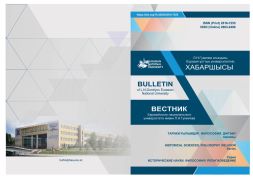The psychosocial aspects of the pilgrimage phenomenon
Research article
Views: 297 / PDF downloads: 146
DOI:
https://doi.org/10.32523/2616-7255-2024-149-4-296-309Keywords:
philosophy of religion; erophany; mausoleum; tomb; pilgrimage phenomenon; sacred pilgrimage; esoteric pilgrimage; pilgrimage tourism; holy placeAbstract
This article from the position of philosophy of religion is devoted to showing the psychological and social significance of the phenomenon of pilgrimage, relevant both at the world level and in Kazakhstan society. In particular, it aims to reveal the nature of pilgrims' prayers and wishes, pilgrimage rituals and the level of religious knowledge. The aim of the article is to analyze empirical data on traditions and practices of pilgrimage to holy places in Kazakhstan to go to the study of mutual influence of pilgrims and holy places from the point of view of psychology and philosophy of religion, determination of feelings, thoughts and expectations of pilgrims. Comparative analysis is conducted and religious, phenomenological, psychosocial research methods are used as methodology. The work is important from a scientific and practical point of view, because the results obtained allow us to determine the philosophy of psychosocial meaning of the tradition of pilgrimage to holy places. As the main result of the research work, it was determined that pilgrimage is carried out based on three principles: performing pilgrimage and paying respect to the spirits of ancestors by consecrating the Qur'an; esoteric pilgrimage based on faith in the mystical power and mystical value of the holy place; sacred pilgrimage for physical and spiritual purification, acceptance of holy places as erophanic space, erotopic place, feeling of the holiness of this place.
Downloads
References
Ali Köse ve Ali Ayten Türbeler. Popüler Dindarlığın Durakları, 1. Basım, Timaş Yayınları, İstanbul 2010. s. 14.
Arslanoğlu İ. Bilimsel Yöntem ve Araştırma Teknikleri. Gazi Kitabevi, Ankara 2016. s. 80.
Aysun Özkan. Türbe Ziyaretlerinin Psiko-Sosyolojik Boyutu (Eyüp Sultan Türbesi Örneği). İstanbul: Marmara Üniversitesi Sosyal Bilimler Enstitüsü, 2009. s. 21.
Aziz Doğanay. Sultan ⅠⅠ. Murad’ın Vasiyetnamesinin Mezar Mimarimize Te’siri. Geçmişten Günümüze Mezarlık Kültürü ve İnsan Hayatına Etkileri Sempozyumu, 1999. s. 102.
Emre Y. Türbe Ziyaretlerinin Fert Üzerindeki Etkileri (Bilecik Örneği). Sakarya Üniversitesi Sosyal Bilimler Enstitüsü, Sakarya, 2009. s. 13.
Filiz Nurhan Ölmez ve Şirin Gökmen. İsparta İl Merkez’inde Bulunan Türbeler. Biliğ, Güz 35, 2005. s. 72.
Osman C. Türbe-Mezar Ziyaretlerinde Görülen Hurafeler ve Çözümleri. Geçmişten Günümüze Mezarlık Kültürü ve İnsan Hayatına Etkileri Sempozyumu, Mezarlık Vakfı Yayınları, İstanbul Kasım 1999. s. 344.
Ünver Günay. Türk Halk Dindarlığının Önemli Çekim Merkezi Olarak Dini Ziyaret Yerleri. Erciyes Üniversitesi Sosyal Bilimler Dergisi, 15, Kayseri 2003. s. 9.
Yılmaz Е. Semra Türbe Ziyaretlerinin Sosyolojik Anlamı. Süleyman Demirel Üniversitesi Sosyal Bilimler Enstitüsü, Isparta 2012. s. 10.
Байпаков К.М. Выдающиеся археологические памятники Казахстана. Алматы: Асыл Сөз, 2014. 504 с.
Байпаков К.М. Исламская археологическая архитектура и археология Казахстана. Алматы: Археологическая экспертиза, 2012. 284 с.
Байпаков К.М., Терновая Г.А. Религии и культы средневекового Казахстана (по материалам городища Куйрыктобе). Алматы: БАУР, 2005. 236 с.
Жандарбек З., Муминов Ә. Насапнама. Иасауи жолының тарихы. Шымкент, 2022. 112 б.
Мамраимов А.М. Священные места на Великом Шелковом пути. Алматы, 2009. 288 б.
Массон М.Е. О постройке мавзолея Ходжа Ахмеда Яссави в г.Туркестане. Среднеазиатское географическое общество. Ташкент, 1929. Т. 19. С. 44-45.
Downloads
Published
How to Cite
Issue
Section
License
Copyright (c) 2024 F. Kamalova, N. Baitenova, J. Dosmagambetova, A. Shaldarbekova

This work is licensed under a Creative Commons Attribution-NonCommercial-NoDerivatives 4.0 International License.








